| کد مقاله | کد نشریه | سال انتشار | مقاله انگلیسی | نسخه تمام متن |
|---|---|---|---|---|
| 6774555 | 1431994 | 2018 | 9 صفحه PDF | دانلود رایگان |
عنوان انگلیسی مقاله ISI
Sustainability of Cold-formed Steel Portal Frames in Developing Countries in the Context of Life Cycle Assessment and Life Cycle Costs
ترجمه فارسی عنوان
پایداری قالب های پورتال فلزی سرد در کشورهای در حال توسعه در راستای ارزیابی چرخه زندگی و هزینه های چرخه زندگی
دانلود مقاله + سفارش ترجمه
دانلود مقاله ISI انگلیسی
رایگان برای ایرانیان
کلمات کلیدی
فولاد سازی سرد فریم های پورتال، تجزیه و تحلیل چرخه عمر، هزینه زندگی چرخه، کشورهای در حال توسعه،
موضوعات مرتبط
مهندسی و علوم پایه
سایر رشته های مهندسی
مهندسی عمران و سازه
چکیده انگلیسی
There is often a demand in developing countries for single-storey buildings, for industrial and agricultural use. Whilst conventional hot-rolled steel sections are still commonly used for the primary column and rafter members, for frames of modest span (up to 30Â m), a viable alternative can be the use cold-formed steel sections. Advantages include pre-galvanised sections that do not require painting to prevent rusting; reduced transportation and acquisition costs as the cold-formed steel used for the secondary members can come from the same supplier; bolted joints that are easy to assemble on site. This paper compares both types of portal steel buildings in terms of a life-cycle assessment (LCA) and a life-cycle cost (LCC). Three sizes of buildings are considered: 18Â m, 24Â m and 30Â m. It is shown that in terms of the primary framing, use of cold-formed steel for the 18Â m and 24Â m span buildings can result in up to 30% less embodied carbon than hot-rolled steel. However, when secondary members and cladding are taken into account in the LCA, the differences in embodied carbon of cold-formed and hot-rolled steel are found to be negligible. LCC is concerned not only with the cost of the steel, but also with the labour costs and the cost of having a crane on site. It is shown that the 18Â m and 30Â m span cold-formed steel frames are cheaper than the hot-rolled steel frames by 33% and 15%, respectively, primarily owing to the fact that the erection of cold-formed steel portal frames have less demand for having a crane onsite. The use of LCA and LCC has therefore helped quantify associated embodied carbon and costs, with differences between section types for the primary framing shown to be relatively negligible when considered in context of the entire building, and the real differences between the two types of steel due to the ease of erection on site.
ناشر
Database: Elsevier - ScienceDirect (ساینس دایرکت)
Journal: Structures - Volume 13, February 2018, Pages 79-87
Journal: Structures - Volume 13, February 2018, Pages 79-87
نویسندگان
Ross P.D. Johnston, Teresa McGrath, Sree Nanukuttan, James B.P. Lim, Marios Soutsos, Mei Chee Chiang, Rehan Masood, Mohammad Afjalur Rahman,
